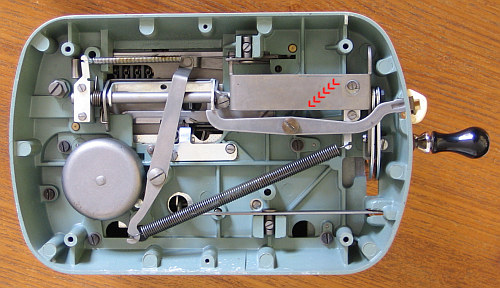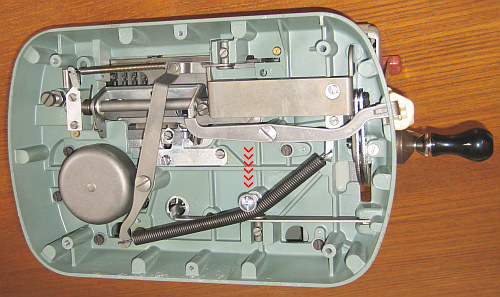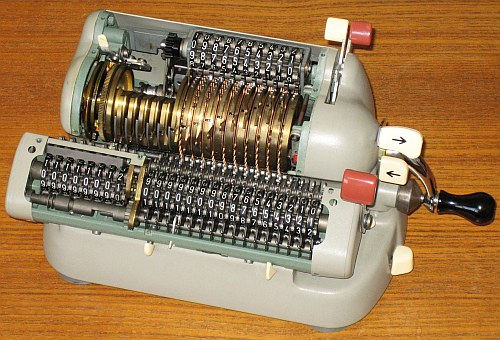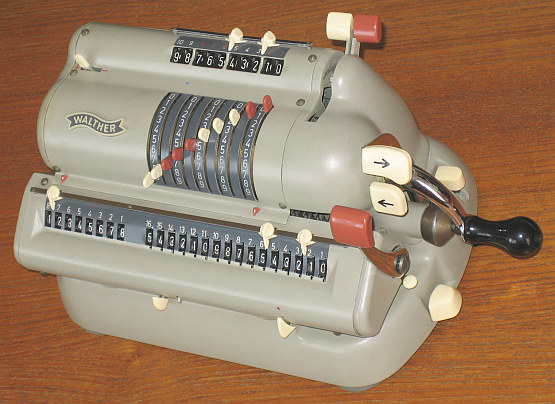T E C H N I C A L D A T A of the Mechanical Calculator WALTHER WSR-160
*************************************************************************
R E M A R K S : Different to other "Odhner-Type" calculators:
Input-Levers are NOT ROTATING, when crank is active!
 MY 1st+FAVOURITE: Precise+Easy + 1-Hand-Operation !
-------------------------------------------------------------------------
Serial Number: 191991
Dimensions: (ca.) Width = 11_3/4" / 30 cm
Depth = 6_1/4" / 16 cm
Height = 5_1/2" / 14 cm
Weight: (ca.) 10 lbs / 4.5 kg
Mechanics: Pin-Wheel / Sprossenrad
10s Carry Mechanism
Functions: Add, Subtract, Multiply, Divide
Back-Transfer / Rueckuebertragung
Registers: Input = 10 Decimals
Counter = 8 Decimals
Arithmetic = 16 Decimals
Manufacturer:
WALTHER Bueromaschinen GmbH
Werk Niederstotzingen
West Germany
1968
H O W T O U S E the WALTHER WSR-160
*******************************************
BASIC SETTINGS:
===============
(A) Crank:
----------
For addition (+) the crank is turned clockwise; for subtraction (-) the
crank is turned counter-clockwise. In the idle position the crank is DOWN
& LOCKED. To make one or more turns with the crank, pull out the handle to
unlock. When finished the turn(s), let the handle snap into lock again. The
locked down position only makes other functions (ex. clearing) accessible.
REMARK: Every started turn has to be finished completely!
Accidentally started turns are correctible somehow.
(B) Clear Counter & Arithmetic Unit in the Carriage:
----------------------------------------------------
Pulling down the BROWN lever RIGHT on the CARRIAGE will clear counter &
arithmetic unit simultaniously - and, when released, let the carriage
jump to the far left position 1 (= Start Position).
EXCEPTIONS: When the WHITE lever RIGHT on the CARRIAGE FRONT is shifted
right, only the arithmetic unit is cleared. When this white
lever is shifted left, only the counter unit is cleared.
REMARK: When this lever is shifted accidentally wrong, it can be
released by lifting the little METAL lever in the MIDDLE of
the CARRIAGE FRONT.
EXCEPTION: When the little WHITE lever on the right side UNDER the
CARRIAGE is switched foreward, the carriage will not jump
(to position 1) after clearing.
REMARK: At any time the arithmetic unit is pre-settable with the
affiliated toothed wheels (16 ... 1).
(C) Clear Input Unit:
---------------------
The input unit will not be cleared automatically after operations. There
is a pair of (white & brown) levers on top: Pulling the WHITE one will
clear the input unit - and will go back when released. Pulling the BROWN
lever clears also the input unit, but prepare it for "Back Transfer"...
REMARK: If pulled the brown lever accidentally, it can be released
by pressing the right WHITE key (RIGHT under the crank).
(D) Back Transfer:
------------------
Clear the input unit with the brown lever - the white one will move too.
When clearing the arithmetic unit, the former content will be transfered
to the input unit, set the input levers and release the white & brown
clearing levers. This is a useful feature for continuous multiplication!
(E) Shifting the Carriage:
--------------------------
The WHITE key on the right side (LEFT under the crank) let the carriage
jump to position 1 from any actual position (= FF-Key ).
In pressing an arrow levers (->) or (<-) the carriage will shift one
step right or one step left.
(F) Counting Direction:
-----------------------
After clearing, the white (+/-) lever (on top, left) is in the middle
position. Depending of the first crank turn (clockwise or counter-
clockwise), the (+/-) lever will go either to (+) or (-). In case of (+)
the counter & arithmetic unit are working in the same direction; in case
of (-) both are working opposite.
ADDITION & SUBTRACTION:
=======================
Example: 123 + 45 - 6 = 162
Clear input, counter & arithmetic units. Carriage in position 1.
ADD: Enter the first number (123) in the far right of the input unit.
Make a positive (clockwise) turn with the crank to transfer the number
into arithmetic unit. The counting unit displays the figure 1. Enter the
second number (45). Make a positive (clockwise) turn with the crank to
add the number. The arithmetic unit displays the intermediate sum (168)
and the counting unit displays the figure 2.
SUBTRACT: Enter the third number (6). Make a negative (counter-clockwise)
turn with the crank. The arithmetic unit displays the result (162) and
the counting unit is decreased by 1.
REMARK: NEGATIVE RESULTS are displayed in the arithmetic unit
as the COMPLEMENT of the next higher 10, 100, 1000, ...
Example: -12 = 99...9988
MULTIPLICATION:
===============
Example: 123 x 45 = 5535
Clear input, counter & arithmetic units.
Enter the multiplicand (123) in the far right of the input unit. The
multiplicator (45) has two digits, so the carriage is shifted to position
2 by pressing the arrow (->) lever. Make positive (clockwise) turns with
the crank, until the first figure of the multiplicator (4) will appear in
the 2nd position of the counter unit. Shift the carriage to position 1 by
pressing the arrow (<-) lever. Repeat making positive turns with the crank,
until the second figure of the multiplicator (5) appears in the 1st posi-
tion of the counter unit. The multiplication is done: The multiplicand
(123) stays in the input unit, the multiplicator (45) in the counter and
the result (5535) is in the arithmetic unit.
DIVISION:
=========
Example: 22 : 7 = 3.1428571 Remainder 3
Clear input, counter & arithmetic units.
Division requires 3 steps:
(A) To Set the Divisor into Input Unit:
---------------------------------------
Enter the DIVISOR (7) in the far right of the input unit.
(B) To Set the Dividend into Arithmetic Unit:
---------------------------------------------
For the maximum number of decimals, pull out the carriage to the far
right. Set the DIVIDENT (22) into the arithmetic unit with the
affiliated toothed wheels appropriately under the divisor.
(C) To Divide:
--------------
Make negative (counter-clockwise) turns with the crank until the
arithmetic unit shows an "underflow". Make one positive (clockwise)
turn with the crank. Move the carriage to the next left position.
Repeat this procedure until the required number of decimals ...
The result (3.1428571) is in the counter unit, and the remainder (3)
is in the arithmetic unit. The divisor (7) stays in the input unit,
therefore an additional decimal can be estimated...
( 4, cause 4 x 7 = 28).
Have a look at "Calculating Trickies" ...
R E M A R K S T O R E S T O R A T I O N :
=========================================================================
I found this WSR-160 "NEW" in Berlin's FleaMarket... and I found out why: MY 1st+FAVOURITE: Precise+Easy + 1-Hand-Operation !
-------------------------------------------------------------------------
Serial Number: 191991
Dimensions: (ca.) Width = 11_3/4" / 30 cm
Depth = 6_1/4" / 16 cm
Height = 5_1/2" / 14 cm
Weight: (ca.) 10 lbs / 4.5 kg
Mechanics: Pin-Wheel / Sprossenrad
10s Carry Mechanism
Functions: Add, Subtract, Multiply, Divide
Back-Transfer / Rueckuebertragung
Registers: Input = 10 Decimals
Counter = 8 Decimals
Arithmetic = 16 Decimals
Manufacturer:
WALTHER Bueromaschinen GmbH
Werk Niederstotzingen
West Germany
1968
H O W T O U S E the WALTHER WSR-160
*******************************************
BASIC SETTINGS:
===============
(A) Crank:
----------
For addition (+) the crank is turned clockwise; for subtraction (-) the
crank is turned counter-clockwise. In the idle position the crank is DOWN
& LOCKED. To make one or more turns with the crank, pull out the handle to
unlock. When finished the turn(s), let the handle snap into lock again. The
locked down position only makes other functions (ex. clearing) accessible.
REMARK: Every started turn has to be finished completely!
Accidentally started turns are correctible somehow.
(B) Clear Counter & Arithmetic Unit in the Carriage:
----------------------------------------------------
Pulling down the BROWN lever RIGHT on the CARRIAGE will clear counter &
arithmetic unit simultaniously - and, when released, let the carriage
jump to the far left position 1 (= Start Position).
EXCEPTIONS: When the WHITE lever RIGHT on the CARRIAGE FRONT is shifted
right, only the arithmetic unit is cleared. When this white
lever is shifted left, only the counter unit is cleared.
REMARK: When this lever is shifted accidentally wrong, it can be
released by lifting the little METAL lever in the MIDDLE of
the CARRIAGE FRONT.
EXCEPTION: When the little WHITE lever on the right side UNDER the
CARRIAGE is switched foreward, the carriage will not jump
(to position 1) after clearing.
REMARK: At any time the arithmetic unit is pre-settable with the
affiliated toothed wheels (16 ... 1).
(C) Clear Input Unit:
---------------------
The input unit will not be cleared automatically after operations. There
is a pair of (white & brown) levers on top: Pulling the WHITE one will
clear the input unit - and will go back when released. Pulling the BROWN
lever clears also the input unit, but prepare it for "Back Transfer"...
REMARK: If pulled the brown lever accidentally, it can be released
by pressing the right WHITE key (RIGHT under the crank).
(D) Back Transfer:
------------------
Clear the input unit with the brown lever - the white one will move too.
When clearing the arithmetic unit, the former content will be transfered
to the input unit, set the input levers and release the white & brown
clearing levers. This is a useful feature for continuous multiplication!
(E) Shifting the Carriage:
--------------------------
The WHITE key on the right side (LEFT under the crank) let the carriage
jump to position 1 from any actual position (= FF-Key ).
In pressing an arrow levers (->) or (<-) the carriage will shift one
step right or one step left.
(F) Counting Direction:
-----------------------
After clearing, the white (+/-) lever (on top, left) is in the middle
position. Depending of the first crank turn (clockwise or counter-
clockwise), the (+/-) lever will go either to (+) or (-). In case of (+)
the counter & arithmetic unit are working in the same direction; in case
of (-) both are working opposite.
ADDITION & SUBTRACTION:
=======================
Example: 123 + 45 - 6 = 162
Clear input, counter & arithmetic units. Carriage in position 1.
ADD: Enter the first number (123) in the far right of the input unit.
Make a positive (clockwise) turn with the crank to transfer the number
into arithmetic unit. The counting unit displays the figure 1. Enter the
second number (45). Make a positive (clockwise) turn with the crank to
add the number. The arithmetic unit displays the intermediate sum (168)
and the counting unit displays the figure 2.
SUBTRACT: Enter the third number (6). Make a negative (counter-clockwise)
turn with the crank. The arithmetic unit displays the result (162) and
the counting unit is decreased by 1.
REMARK: NEGATIVE RESULTS are displayed in the arithmetic unit
as the COMPLEMENT of the next higher 10, 100, 1000, ...
Example: -12 = 99...9988
MULTIPLICATION:
===============
Example: 123 x 45 = 5535
Clear input, counter & arithmetic units.
Enter the multiplicand (123) in the far right of the input unit. The
multiplicator (45) has two digits, so the carriage is shifted to position
2 by pressing the arrow (->) lever. Make positive (clockwise) turns with
the crank, until the first figure of the multiplicator (4) will appear in
the 2nd position of the counter unit. Shift the carriage to position 1 by
pressing the arrow (<-) lever. Repeat making positive turns with the crank,
until the second figure of the multiplicator (5) appears in the 1st posi-
tion of the counter unit. The multiplication is done: The multiplicand
(123) stays in the input unit, the multiplicator (45) in the counter and
the result (5535) is in the arithmetic unit.
DIVISION:
=========
Example: 22 : 7 = 3.1428571 Remainder 3
Clear input, counter & arithmetic units.
Division requires 3 steps:
(A) To Set the Divisor into Input Unit:
---------------------------------------
Enter the DIVISOR (7) in the far right of the input unit.
(B) To Set the Dividend into Arithmetic Unit:
---------------------------------------------
For the maximum number of decimals, pull out the carriage to the far
right. Set the DIVIDENT (22) into the arithmetic unit with the
affiliated toothed wheels appropriately under the divisor.
(C) To Divide:
--------------
Make negative (counter-clockwise) turns with the crank until the
arithmetic unit shows an "underflow". Make one positive (clockwise)
turn with the crank. Move the carriage to the next left position.
Repeat this procedure until the required number of decimals ...
The result (3.1428571) is in the counter unit, and the remainder (3)
is in the arithmetic unit. The divisor (7) stays in the input unit,
therefore an additional decimal can be estimated...
( 4, cause 4 x 7 = 28).
Have a look at "Calculating Trickies" ...
R E M A R K S T O R E S T O R A T I O N :
=========================================================================
I found this WSR-160 "NEW" in Berlin's FleaMarket... and I found out why:
  The "FF-KEY" was not moving, because ( s. [ <<<< ] ) the SCREW's cylinder
was too short and pressed the "FF"-Lever on its base - SOLUTION = WASHER!
GUESS: This fresh bought WSR-160 was put aside & forgotten ... LUCKY ME!!
P O S T S C R I P T : "Half-Year-Maintenance" in 06/2018 ...
The "FF-KEY" was not moving, because ( s. [ <<<< ] ) the SCREW's cylinder
was too short and pressed the "FF"-Lever on its base - SOLUTION = WASHER!
GUESS: This fresh bought WSR-160 was put aside & forgotten ... LUCKY ME!!
P O S T S C R I P T : "Half-Year-Maintenance" in 06/2018 ...
 ... A SCREW, put in the open hole, direct the SPRING's FORCE better!
... A SCREW, put in the open hole, direct the SPRING's FORCE better!

 "PHOENIX-ZAHL" Experiment "PHOENIX-ZAHL" Experiment  impressum:
*************************************************************************
© C.HAMANN http://public.BHT-Berlin.de/hamann 09/12/99
impressum:
*************************************************************************
© C.HAMANN http://public.BHT-Berlin.de/hamann 09/12/99
|

 MY 1st+FAVOURITE: Precise+Easy + 1-Hand-Operation !
-------------------------------------------------------------------------
Serial Number: 191991
Dimensions: (ca.) Width = 11_3/4" / 30 cm
Depth = 6_1/4" / 16 cm
Height = 5_1/2" / 14 cm
Weight: (ca.) 10 lbs / 4.5 kg
Mechanics:
MY 1st+FAVOURITE: Precise+Easy + 1-Hand-Operation !
-------------------------------------------------------------------------
Serial Number: 191991
Dimensions: (ca.) Width = 11_3/4" / 30 cm
Depth = 6_1/4" / 16 cm
Height = 5_1/2" / 14 cm
Weight: (ca.) 10 lbs / 4.5 kg
Mechanics: 
 The "FF-KEY" was not moving, because ( s. [ <<<< ] ) the SCREW's cylinder
was too short and pressed the "FF"-Lever on its base - SOLUTION = WASHER!
GUESS: This fresh bought WSR-160 was put aside & forgotten ... LUCKY ME!!
P O S T S C R I P T : "Half-Year-Maintenance" in 06/2018 ...
The "FF-KEY" was not moving, because ( s. [ <<<< ] ) the SCREW's cylinder
was too short and pressed the "FF"-Lever on its base - SOLUTION = WASHER!
GUESS: This fresh bought WSR-160 was put aside & forgotten ... LUCKY ME!!
P O S T S C R I P T : "Half-Year-Maintenance" in 06/2018 ...
 ... A SCREW, put in the open hole, direct the SPRING's FORCE better!
... A SCREW, put in the open hole, direct the SPRING's FORCE better!

